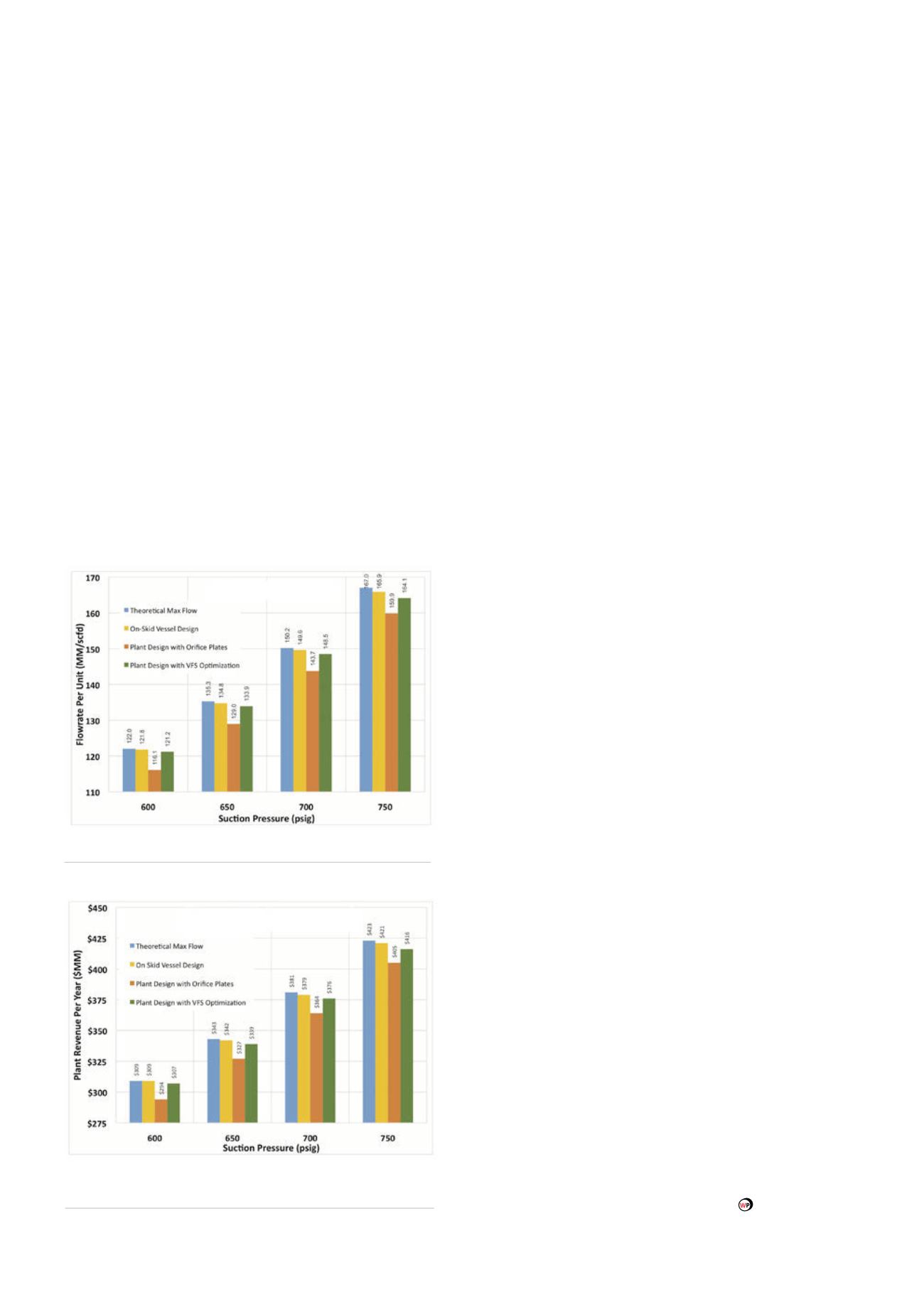
design. SNC-Lavalin proposed three compressor units with the
following configuration, subsequently installed on common
header piping:
)
)
Driver: Waukesha 16V275GL+.
)
)
Rated bhp: 4835 bhp at 1000 RPM.
)
)
Compressor: Ariel JGC/6.
)
)
Cylinders: 12.5 CM, 9.75 CM.
)
)
Stages: two.
)
)
Suction pressure: 250 - 750 psig.
)
)
Discharge pressure: 1250 psig.
)
)
Design flowrate: 167 million ft
3
/d per unit.
The compressor frame, cylinder and driver combination
was selected to maximise the flowrate across the operating
range. SNC-Lavalin conducted an on-skid pulsation analysis of
the compressor units and proposed an optimised vessel design
that was within API 618 (5
th
edition) pulsation and mechanical
guidelines. At the time of the on-skid analysis, the off-skid plant
piping layout was being designed by the EPC firm and was not
included in the SNC-Lavalin scope of evaluation.
Plant design with off-skid piping
A pulsation study was conducted on the off-skid plant piping by
another firm. Due to higher than allowable pressure pulsations
observed in the off-skid piping, multiple restriction orifice plates
were recommended. The parasitic losses associated with the
additional orifice plates would result in a loss of 17.6 million ft
3
/d
station throughput and a corresponding revenue loss of
US$15 million/y (calculated at US$2.27 per million Btu) for the
end user.
The end user requested SNC-Lavalin to review the plant
design and conduct an independent acoustic analysis. SNC-
Lavalin conducted the plant header study and confirmed that
the pressure pulsation in the plant piping was higher than
allowable. Using orifice plates in the piping would have reduced
pulsation, but at the cost of efficiency and capacity. As a result,
SNC-Lavalin looked for other methods to reduce pulsation
while maintaining the desired flowrate of the plant. The
pulsation in the piping was amplified due to reflection points
in the off-skid piping. Multiple compressor units on a common
header also generated higher pulsation in the header and the
unit discharge lines. Since changing line sizes or layout was cost
prohibitive, it was necessary to filter the pulsation frequencies
of individual units without creating additional pressure loss.
SNC-Lavalin designed two additional off-skid volume
bottles per unit (one vessel on each stage discharge line). The
location of the vessel on the off-skid piping was optimised to
get the best acoustic response. The size of each vessel was then
optimised to reduce the line pulsation within API 618, 5
th
Edition
guidelines (Figure 2 and 3). The calculated pressure drop due to
secondary off-skid volumes was minimal.
Conclusions
Development of the shale resources with variable or declining
well pressure requires compressors to operate over a wide
operating range. Maximising flowrate throughout the operating
range extends the profitability of the compression asset over its
lifecycle.
Traditionally, pulsations generated by the compressor are
controlled by utilising large pressure vessels and restriction
orifice plates. Large discharge vessels are not desirable, as it
raises the centre of gravity of the compressor frame, resulting in
increased mechanical vibrations.
Restriction orifice plates control pressure pulsation in the
pipeline but result in a permanent pressure drop in the system.
Parasitic load due to pressure drop should be minimised, since it
has an inverse correlation with the compressor flowrate.
Optimising the compressor unit on-skid vessel and piping
design is not enough to ensure maximum throughput. A
complete plant header study is needed to evaluate methods to
reduce pulsation while maintaining the desired flowrate of the
plant.
In the case study presented in this article, SNC-Lavalin
designed two additional off-skid volume bottles to reduce
pulsation in the plant piping within API 618 (5
th
edition)
guidelines. The design optimisation conducted by SNC-Lavalin
avoided a flowrate loss of 12.6 million ft
3
/d and corresponding
revenue of US$11 million/y (Figure 4 and 5).
Figure 4.
Flowrate per unit.
Figure 5.
Plant revenue per year (US$ million): calculated at
US$2.27/million Btu.
56
World Pipelines
/
MARCH 2016


